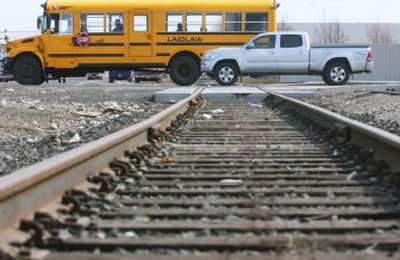Rail crossings targeted

The arms descended, lights flashed, but Post Falls police Lt. Scot Haug watched in horror as a driver continued over the railway tracks.
“The arms actually came down on her car and bounced off her windshield,” said Haug. “I stopped her and came to find out she was elderly and just wasn’t paying attention. You cringe to see that.”
It could have been worse, though. Haug has responded to a troubling number of fatal collisions between cars and trains in his years in law enforcement.
Crashes at rail crossings hit an all-time low in 2005, according to recently released Federal Railroad Administration statistics, but they are still a concern to local officials who are working to close down about 70 at-grade crossings in Spokane and Kootenai counties.
The $270 million plan, called Bridging the Valley, will target many of the region’s most potentially dangerous crossings over the next six to seven years, but leave some others untouched.
Bridging the Valley’s goal is to build overpasses or underpasses at several key BNSF crossings, closing nearby at-grade crossings. The BNSF line will also be expanded to accommodate Union Pacific traffic. At that time most Union Pacific at-grade crossings will also be closed.
Just one of the five most hazardous crossings in Spokane County is on the main BNSF and Union Pacific lines Bridging the Valley will address. That’s the Pines crossing just south of Trent Avenue in Spokane Valley.
The remaining four are on spur lines serving industrial areas. They have little train traffic, but also no crossing gates. Three are in the industrial area along Freya between Sprague and Broadway. The last is on Thierman Road at Mission Avenue.
The rankings are updated regularly by the Washington Utilities and Transportation Commission’s rail section.
Kootenai County’s most hazardous crossings, as ranked by the Federal Railroad Administration, include at-grade rail intersections at Beck Road in State Line, Chase and McGuire roads in Post Falls, Mill Street in Rathdrum and the BNSF Highway 54 crossing in Athol.
A new underpass at Main Street in Rathdrum will replace the Mill Street crossing. That project is now scheduled to be built in 2007, along with an overpass at Havana Street in Spokane.
Though the Havana Street crossing doesn’t rank as high on the danger list, it’s a huge priority for Spokane, said Spokane County Regional Transportation Council Director Glenn Miles, who is heading up the Bridging the Valley project.
“Havana is a major arterial, and is closed up to 18 hours a day being at the rail yard,” Miles said of its location at BNSF’s Spokane hub. Building an overpass there will greatly improve north-south traffic flow in the future.
Bridging the Valley plans also call for building a highway underpass at the crossing in Athol and closing the McGuire Road crossing. And the Chase Road and Beck Road crossings – both on the Union Pacific line – will eventually lose most, if not all, of their train traffic when UP’s main line is moved onto the BNSF track.
The Union Pacific line is a major concern in Post Falls because suburban development now runs right up to it, said Miles. Golfers even have to cross it to make their way to some holes at one golf course.
In Spokane County, the Pines Road crossing was the site of a 2001 train-vehicle accident that killed two people. Under Bridging the Valley, an underpass for vehicle traffic will be built at that location, and the project will straighten the intersection, said Miles.
A specific timeline hasn’t been determined for the Pines crossing improvements, but they won’t be undertaken until underpasses and overpasses are complete at Havana and Park Road in Spokane County and Rathdrum and Pleasant View Road in Kootenai County.
In fact it’s uncertain when most of the projects will be completed because funding isn’t available for them all at this time, said Miles.
Eliminating at-grade crossings has been a primary Federal Railroad Administration goal since 1994, said FRA spokesman Steve Kulm.
But that emphasis doesn’t always translate into funding. Many improvements are paid for by state or local governments, not the federal government or railroads.
“With the limited amount of funding we have, I can only program out four to six crossings a year,” said Joseph Peagler, the rail highway safety coordinator for the Idaho Department of Transportation.
And that’s for the entire state.
Kulm said the majority of vehicle-train crashes are the fault of inattentive or foolhardy drivers who don’t watch for trains or cross even though they know a train is approaching.
So until more at-grade crossings are closed, it’s up to drivers to be careful.
“People disregard the signals and break the law and get hit by trains,” said Peagler. “Almost across the board, it’s some human factor.”